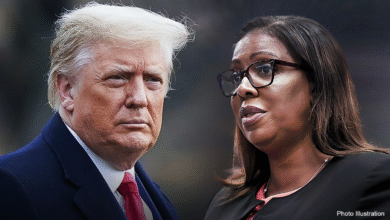Federal Reserve Interest Rates: Powell Faces Key Decisions

Federal Reserve interest rates have become a topic of intense discussion as market analysts and policymakers anticipate significant changes following Federal Reserve Chair Jerome Powell’s upcoming testimony to Congress. As he prepares to address lawmakers, both external pressures from the White House and internal dissent within the Fed may steer Powell towards reconsidering the current monetary policy framework. The prospect of an interest rate cut is especially palpable, given that several Fed officials have hinted at the urgency for a decision as early as July. With rate cut predictions gaining traction, stakeholders are closely monitoring the upcoming Fed meeting, where Powell will navigate the political landscape while balancing economic indicators. As tensions rise and expectations shift, the implications of Federal Reserve interest rates could shape the economic outlook in the months ahead.
The discussion surrounding the Federal Reserve’s benchmark rates is underscored by significant political and economic dynamics, affecting everything from consumer loans to mortgage rates. Recent statements from notable figures within the Federal Reserve indicate a potential shift in monetary policy, focusing on easing the pressure through potential rate cuts. Observers are keenly aware that forthcoming meetings will reveal how the central banking system adapts to external demands while fulfilling its economic mandates. The interplay of political influences and market forecasts creates a complex backdrop, where decisions made about interest rates hold the power to dramatically impact both inflation and employment rates across the country. As the landscape evolves, stakeholders are left wondering how bold the Fed will be in its adjustments amidst mounting pressures.
The Role of the Federal Reserve in Economic Stability
The Federal Reserve plays a crucial role in maintaining economic stability by regulating the money supply and interest rates. As the central banking system of the United States, it ensures that inflation remains in check while also promoting maximum employment. By adjusting interest rates, the Fed influences borrowing costs, which in turn affects consumer spending and business investments. When interest rates are low, it is easier for consumers to take out loans for homes, cars, and education, which stimulates economic growth. Conversely, when rates are high, borrowing decreases, potentially slowing down the economy.
In the context of the current economic landscape, Federal Reserve Chair Jerome Powell’s upcoming testimony before Congress highlights the challenges faced in balancing these two mandates. With increasing pressure from both political parties and external factors, Powell must articulate the Fed’s approach to interest rates while considering the broader implications on economic health. It’s essential for the Fed to maintain its independence from political pressures to ensure long-term economic stability. This delicate balance requires analyzing economic indicators such as inflation rates, employment statistics, and market trends.
Jerome Powell’s Upcoming Testimony and Its Implications
Jerome Powell’s semiannual testimony before Congress is expected to be particularly contentious this time around, as calls for a rate cut grow louder from both political and financial sectors. During his sessions with the House Financial Services and Senate Banking Committees, Powell will need to address these pressures and provide insights into the Federal Reserve’s current monetary policy. Analysts are closely watching to see if he will succumb to calls for a reduction in interest rates, which could lead to significant shifts in market sentiment and economic projections.
The implications of Powell’s testimony extend beyond immediate reactions; it can shape rate cut predictions and influence investor behavior in the stock and bond markets. Investors are particularly attuned to comments regarding the Fed’s stance on interest rates, as any signal towards an imminent cut could spur increased trading activity. With Wall Street abuzz about the potential for a rate cut, understanding Powell’s articulation of the Fed’s monetary policy goals during this testimony will be critical for market participants.
Influence of Political Pressure on Monetary Policy
The increasing political pressure on the Federal Reserve, particularly from President Trump and his administration, raises concerns about the independence of monetary policy. Historically, the Fed has operated with a degree of autonomy, making decisions based on economic data rather than political motivations. However, as noted by various economists including Mohamed El-Erian, the presence of Republican-leaning governors advocating for a rate cut adds a layer of complexity to Powell’s ability to navigate this political landscape without compromising the Fed’s core objectives.
Moreover, as political figures advocate for drastic rate cuts, there is a risk that the Fed may inadvertently lose its credibility in the eyes of the public and markets. Effective monetary policy requires that the Fed be perceived as acting in the best interest of the economy rather than bowing to political whims. Ultimately, maintaining this independence is essential for the long-term effectiveness of the Fed’s strategies in promoting economic stability and growth.
Rate Cut Predictions Amidst Economic Uncertainty
Current market sentiments reflect rising expectations for rate cuts in the coming months, particularly with traders increasing the likelihood of a reduction in July to about 23%. The CME Group’s FedWatch tool indicates an even stronger 82% chance for a cut in September, suggesting that many are anticipating a shift in the Fed’s monetary policy framework. However, these predictions must be tempered with caution as economic indicators continue to evolve, and inflation remains a critical concern.
Powell’s upcoming testimony will likely shed light on the Fed’s considerations regarding these rate cut predictions. With evidence of mixed economic signals, including inflation trends and employment data, the Federal Reserve’s decision-making process may not be as straightforward as market participants hope. Thus, while the potential for rate cuts exists, the broader implications for the economy must be carefully weighed to avoid destabilizing effects on inflation and long-term growth.
Impact of Federal Reserve Interest Rates on the Economy
Federal Reserve interest rates have a profound impact on economic activities, affecting everything from consumer spending to investment decisions. When the Fed lowers rates, it effectively reduces the cost of borrowing, encouraging businesses to invest in expansion and consumers to finance purchases. This increased capital circulation can lead to job creation and overall economic growth. On the other hand, hasty reductions or increases in rates can disrupt market stability, leading to unintended consequences, such as increased inflation or asset bubbles.
The dynamics of the Fed’s interest rate adjustments are particularly noteworthy in the context of the current economic environment. With recent indications from Fed officials such as Bowman and Waller supporting the case for a rate cut, attention has turned to how these decisions align with broader economic mandates. Powell must navigate these turbulent waters, ensuring that rate decisions are based on sound economic analysis rather than political pressures, ultimately striving for a balanced approach that fosters sustainable growth.
The Federal Open Market Committee (FOMC) and Its Decisions
The Federal Open Market Committee (FOMC) plays a pivotal role in determining the direction of U.S. monetary policy and interest rates. Comprised of twelve members, including the Federal Reserve Chair, the FOMC convenes regularly to assess economic conditions and make crucial decisions about rate adjustments. Their decisions can significantly influence national economic trends, as evidenced by trader sentiments that respond swiftly to FOMC announcements and Powell’s testimonials.
In recent meetings, FOMC members displayed a divided stance regarding rate cuts, with differing opinions on how best to respond to current inflationary pressures and economic growth forecasts. The discussions surrounding these decisions are critical, as they not only shape current economic conditions but also set the tone for long-term monetary policy strategies. It’s essential for the FOMC to reach a consensus that aligns with empirical economic data to maintain credibility and support the Fed’s primary goals of price stability and maximum sustainable employment.
Market Reactions to Fed Rate Changes
Market reactions to changes in Federal Reserve interest rates are often immediate and impactful. A decision to cut rates typically results in bullish sentiment in stock markets, as cheaper borrowing costs are viewed favorably by investors. Conversely, the failure to lower rates or an increase can lead to market sell-offs, as investors recalibrate their expectations for growth and corporate earnings. The interconnectedness of interest rates with market performance cannot be overstated, as they serve as a critical barometer of economic health.
In the lead-up to Powell’s testimony, Wall Street’s anticipation of potential rate cuts reflects the significant weight that Fed decisions carry in shaping market dynamics. As traders reassess risks and opportunities based on evolving expectations from the FOMC, it underscores the careful watch required on monetary policy cues. The delicate balance that the Fed must maintain between fostering economic growth and avoiding inflationary pressures highlights the broader implications that arise from its interest rate decisions.
Long-term Considerations for Federal Reserve Policy
As Jerome Powell and the Federal Reserve navigate the current economic climate characterized by calls for rate cuts and political pressures, long-term considerations must be at the forefront of their policy decisions. The Fed’s primary mandates, including stability in inflation and employment, should guide its actions rather than short-term political motivations. This long-term perspective is crucial in ensuring that any rate adjustments do not inadvertently create more significant economic challenges down the road.
Market observers point out that the Fed’s credibility relies heavily on its adherence to its established mandates and an objective approach to monetary policy. Striking the right balance between consumer demand, inflationary pressures, and overall economic growth requires a keen analysis that looks beyond immediate political pressures. The ability of the Fed to remain steadfast in its commitment to sound monetary principles will ultimately dictate its effectiveness in guiding the U.S. economy through uncertain times.
Challenges Ahead for the Federal Reserve Chairperson
As Powell prepares for his testimony, he is faced with the unique challenge of balancing conflicting demands from Congress, market participants, and the White House. While pressure mounts for immediate action, Powell must emphasize the importance of data-driven decision-making to avoid precipitating instability within the economy. The interactions with lawmakers are anticipated to be contentious as they question the Fed’s current approach amidst rising inflation and economic uncertainties.
In addition to political scrutiny, Powell must navigate internal dynamics within the Federal Reserve, particularly with newer members like Waller and Bowman advocating for a rate cut. This divergence within the FOMC could lead to inconsistencies in messaging and potential misalignment with the Fed’s broader strategies. Effective leadership will require Powell to articulate a coherent approach to monetary policy that adheres to the Fed’s mission while addressing immediate political and market pressures.
Frequently Asked Questions
What are the implications of Federal Reserve interest rates on the economy?
Federal Reserve interest rates play a pivotal role in shaping economic conditions. Lower interest rates can stimulate borrowing and spending, leading to economic growth, while higher rates typically help curb inflation. The Fed’s monetary policy, including rate adjustments by Chair Jerome Powell, aims to balance these factors to promote employment and stabilize inflation.
How does Federal Reserve Powell’s testimony affect interest rate decisions?
Federal Reserve Powell’s testimony before Congress is crucial as it offers insights into the Fed’s monetary policy direction. His statements can influence perceptions around interest rate cuts, aiding market expectations for future adjustments. For instance, if Powell signals openness to rate cuts, it may increase speculation about imminent changes to Federal Reserve interest rates.
What are current predictions for interest rate cuts by the Federal Reserve?
Current predictions for Federal Reserve interest rates suggest a growing chance of cuts as early as September, with markets pricing in an 82% possibility. Recent comments from Fed officials, such as Powell, Waller, and Bowman, have fueled discussions around potential rate cuts, reflecting a shift toward a more accommodating monetary policy influenced by external political pressures.
Why is there political pressure on the Federal Reserve to cut interest rates?
Political pressure on the Federal Reserve to cut interest rates stems from concerns about economic growth and employment. Influential political figures, including President Trump, have advocated for significant rate reductions to stimulate the economy. Fed officials are navigating these pressures while maintaining their mandate to ensure stable inflation and employment, complicating the decision-making process.
What factors influence the Federal Reserve’s decisions on interest rates during meetings?
During Federal Reserve meetings, various factors influence decisions on interest rates, including economic data on inflation and employment, financial market conditions, and political climate pressures. The Fed aims to assess whether their current interest rate policy is aligned with economic goals, especially when facing calls for rate cuts or changes to monetary policy.
What role does monetary policy play in Federal Reserve interest rate decisions?
Monetary policy is integral to Federal Reserve interest rate decisions. It encompasses actions like adjusting the federal funds rate to influence overall economic activity. The Fed, under Chair Jerome Powell, employs monetary policy tools to stabilize inflation and employment, aiming to foster sustainable economic growth while responding to changing financial landscapes.
How do market expectations shape the Federal Reserve’s interest rate policy?
Market expectations significantly shape the Federal Reserve’s interest rate policy. Investors closely monitor Fed indications about future rate changes, which can impact market behavior and economic projections. The heightened speculation around rate cuts, particularly after comments from officials like Powell, reflects how anticipated monetary policy shifts can influence overall market dynamics.
What are rate cut predictions related to the upcoming Fed meeting?
Rate cut predictions suggest that the Federal Reserve may reduce interest rates in the upcoming meetings, particularly as analysts project an 82% chance of a cut in September. Influential discussions among Fed officials, combined with increasing financial market pressures, contribute to this outlook as attention turns to upcoming economic data.
| Key Points |
|---|
| Federal Reserve Chair Jerome Powell faces pressure to lower interest rates from both Congress and the White House. |
| Powell’s testimonies to Congress are scheduled for Tuesday and Wednesday, addressing economic conditions and monetary policy. |
| Political pressures from President Trump and some Fed governors suggest a shift towards possible rate cuts in July or September. |
| Market speculation indicates a 23% chance for a rate cut in July and an 82% chance for a move in September, according to FedWatch. |
| Tensions in Congress may increase due to differing political views on the timing and extent of rate cuts, with both parties demanding action. |
| Critics argue that the call for drastic cuts is irresponsible and could compromise the Fed’s core mandates of inflation and employment stabilization. |
Summary
Federal Reserve interest rates are currently a hot topic as Chair Jerome Powell prepares to testify before Congress amid significant political pressure. While traders are closely watching for indications of rate cuts, it is crucial to balance these considerations with the Fed’s mandate to stabilize inflation and employment. Moreover, the risks of aligning monetary policy too closely with political pressures could jeopardize the Fed’s credibility and the economic stability it aims to uphold.




